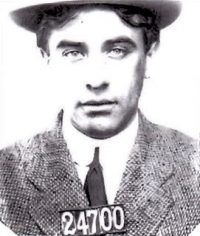
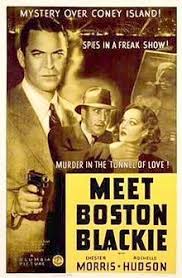 Boston Blackie (1944, 1945-1950) aired “TV Poisoning” on December 20, 1945 as the 36th broadcast of the estimated 220 from its 1945-1950 run. This is but the fourth episode of this program we have showcased, the last coming in December of 2020, with the one previous to that being over two years ago in January of 2019; so for newcomers I recap below the rather fascinating history of the man behind the stories that eventually led to Boston Blackie coming to radio, film, and even early television. The show was produced originally in 1944 as a 13-episode summer replacement for the Amos & Andy Show. It proved popular enough and aired its first show in April of 1945, but under different ownership (ZIV productions, running on NBC in its own time slot), format, and actors. Chester Morris played Boston Blackie while Richard Lane played the part of Inspector Farraday in the 1944 replacement episodes, though in its official 1945 incarnation Richard Kollmar (1910-1971, photo middle right) became Boston Blackie, primarily due to contractual film obligations that stood in the way of Chester Morris continuing the role.
Boston Blackie (1944, 1945-1950) aired “TV Poisoning” on December 20, 1945 as the 36th broadcast of the estimated 220 from its 1945-1950 run. This is but the fourth episode of this program we have showcased, the last coming in December of 2020, with the one previous to that being over two years ago in January of 2019; so for newcomers I recap below the rather fascinating history of the man behind the stories that eventually led to Boston Blackie coming to radio, film, and even early television. The show was produced originally in 1944 as a 13-episode summer replacement for the Amos & Andy Show. It proved popular enough and aired its first show in April of 1945, but under different ownership (ZIV productions, running on NBC in its own time slot), format, and actors. Chester Morris played Boston Blackie while Richard Lane played the part of Inspector Farraday in the 1944 replacement episodes, though in its official 1945 incarnation Richard Kollmar (1910-1971, photo middle right) became Boston Blackie, primarily due to contractual film obligations that stood in the way of Chester Morris continuing the role.
The Boston Blackie character first appeared in a series of short stories, the first in 1914 in The American Magazine by author Jack Boyle (1881-1928, photo top right). Boyle led a short but colorful life, spending two stints in prison for passing bad checks and forgery. Details of his life between the years 1908 and 1914, according to this website, are scarce, though through diligent research and some luck it was discovered that Boyle spent 10 months in San Quentin (mug shot top right) beginning on December 17, 1910 and was released the following October; though a few years later in 1914 he would be serving another stint in the joint, this time in a Colorado state prison for much the same offenses.
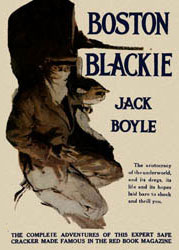
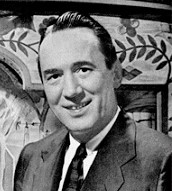 Turning what he knew into what he would write, Boyle then created the fictional character of Boston Blackie, a reformed jewel thief and safe-cracker who had done prison time and was now an “Enemy to those who make him an enemy. Friend to those who have no friend.” Blackie is aided in his capers by his rather slow-witted sidekick Runt, and is hounded by police Inspector Farraday (the police inspector working against, or trying to pin the blame for crimes against the hero being a popular formula that became a staple, i.e. The Shadow, Rocky Jordan, The Green Hornet, and many others in print, radio, and film). Boyle’s stories hit the right chord and a whopping 11 silent films featuring Blackie were made from 1918-1927. The series was picked up in 1941 with Chester Morris in the lead as Blackie in Meet Boston Blackie, the first of what would be 14 total films, the final one to hit the silver screen in 1949 and all starring Chester Morris. When the new medium of television became all the rage Boston Blackie was among the first to jump on board with Boston Blackie. It debuted in 1951, ran for 58 half-hour episodes until 1953, and would then air in syndication for almost another ten years. An interesting side note is that of Blackie’s 58 TV shows 32 were shot in color, while the remaining 26 were shot in black & white, shooting in color something unheard of at the time (and expensive) for an early television show. But the producers were ahead of their time and gambled that when color became more widely available there would be a market for color reruns. Thus, Boston Blackie would join the ranks of the few early TV shows also shot at least in part in color, Superman and The Cisco Kid two favorites coming to mind.
Turning what he knew into what he would write, Boyle then created the fictional character of Boston Blackie, a reformed jewel thief and safe-cracker who had done prison time and was now an “Enemy to those who make him an enemy. Friend to those who have no friend.” Blackie is aided in his capers by his rather slow-witted sidekick Runt, and is hounded by police Inspector Farraday (the police inspector working against, or trying to pin the blame for crimes against the hero being a popular formula that became a staple, i.e. The Shadow, Rocky Jordan, The Green Hornet, and many others in print, radio, and film). Boyle’s stories hit the right chord and a whopping 11 silent films featuring Blackie were made from 1918-1927. The series was picked up in 1941 with Chester Morris in the lead as Blackie in Meet Boston Blackie, the first of what would be 14 total films, the final one to hit the silver screen in 1949 and all starring Chester Morris. When the new medium of television became all the rage Boston Blackie was among the first to jump on board with Boston Blackie. It debuted in 1951, ran for 58 half-hour episodes until 1953, and would then air in syndication for almost another ten years. An interesting side note is that of Blackie’s 58 TV shows 32 were shot in color, while the remaining 26 were shot in black & white, shooting in color something unheard of at the time (and expensive) for an early television show. But the producers were ahead of their time and gambled that when color became more widely available there would be a market for color reruns. Thus, Boston Blackie would join the ranks of the few early TV shows also shot at least in part in color, Superman and The Cisco Kid two favorites coming to mind.
“TV Poisoning” opens with Blackie and paramour fiddling with a new invention–the television–waiting to tune in to a roundtable discussion featuring local personalities, including Inspector Farraday (who it is obvious Blackie has no love for). When a local civic leader is about to speak, ostensibly to reveal something important, he slumps over dead, murdered on live TV. Blackie’s interest is piqued and he inserts himself into the search for the killer, much to the chagrin of Inspector Farraday. And quite an unusual search it becomes, for before anyone can be thought of as a suspect it must first be discovered just how the murderer was able to assemble the parts to his cleverly constructed homicide, and then work backwards from there, not only uncovering the killer but why this certain civic leader had to be silenced. An interesting little murder caper, indeed, and a worthy challenge for the detective abilities of Boston Blackie.
With this episode dealing with early television, I found myself curious about Boston Blackie‘s radio ratings being as solid as they were during a time when the relatively new invention of television might have drawn some listeners away from it and other radio programs, so did some informational digging (i.e., light research). When this story took place in 1945 the population of the United States was 140 million. There were estimated to be only 10,000 commercial television sets in the country, and only 0.5% of households a year later in 1946 had a set. Four years later in 1950 there were 6 million tv sets. And today in the United States it is estimated that over 300 million tv sets exist–-at least one for every man, woman, and child in the country. The sharp rise in sets sold after the war ended in 1945 was due to the fact that the government had put a virtual halt to their manufacture during the war (raw materials were needed for the war effort), and this restriction was lifted in late 1945. So sales of the relatively new invention skyrocketed and television was all the rage among those who could afford one.
Play Time: 26:18
{This episode of Boston Blackie aired on a Thursday evening in 1945, so it was no surprise to find the neighborhood gang heading for the nearby newsstand after school the next day. Still in the mood for detective fare after “TV Poisoning,” they found magazines satisfying that singular inclination as well as others with the benefit of supplying the synergistic element of a “super-hero” detective. The Phantom Detective (1933-53) was Standard Magazine’s counterpart to Street & Smith’s The Shadow. While it outlasted S&S’s The Shadow—primarily due to its less frequent schedule, it nevertheless holds the record for the longest running single-character pulp. A monthly until the end of 1941, it then produced fewer issues for a few years, then became bi-monthly (1944-48) and ended its run as a quarterly from 1950-53. The Shadow (1931-49) was a bi-weekly magazine until the middle of 1943 (the WW II paper shortage no doubt the reason). It then became a monthly through 1946, then tapered off to end its run with three quarterly issues in 1949. As noted above, it was such a successful magazine with an obviously popular hero in various media that it spawned several offshoot/competing characters and magazines, including Doc Savage and The Avenger as well as The Phantom Detective. Super-Detective (1934-50) also enjoyed a respectable run, but with the clarification that while debuting in 1934 it ceased publication in 1935 after only 15 issues. It was then revived in 1940 with a pulp character named Jim Anthony as a scientist/adventurer (sounds a tad like Doc Savage, doesn’t it?), with a full length Jim Anthony novel featured in each issue until 1943. It then continued as a successful detective magazine for another 65 issues, but it never maintained any kind of regular schedule for more than a year. It saw 9 issues in 1945.}
[Left: Phantom Detective, Dec. 1945 – Center: The Shadow, Dec. 1945 – Right: Super-Detective, Nov. 1945]
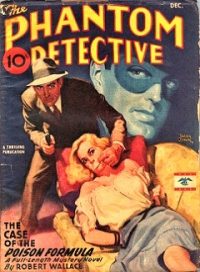
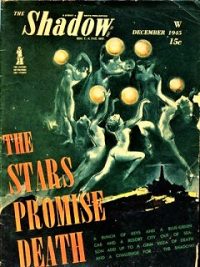
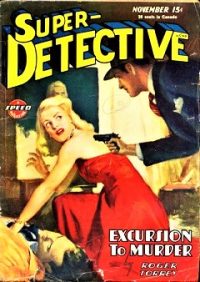
To view the entire list of weekly Old Time Radio episodes at Tangent Online, click here.